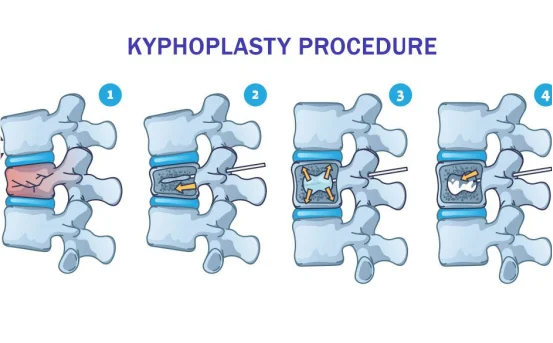Types of kyphoplasty surgery has emerged as a leading treatment for spinal compression fractures, especially those caused by osteoporosis, cancer, or trauma. This minimally invasive procedure is designed to relieve pain, restore vertebral height, and stabilize fractured vertebrae. While the term kyphoplasty generally refers to a specific technique, there are actually several types or variations of kyphoplasty surgery, each with unique approaches and benefits.
Back pain and spinal fractures are increasingly common, especially among the elderly and individuals with weakened bones due to osteoporosis, cancer, or trauma. One of the most effective solutions for vertebral compression fractures (VCFs) is a minimally invasive procedure known as kyphoplasty surgery. This technique not only offers quick pain relief but also restores vertebral height and helps patients return to normal activities much sooner than with traditional treatments.
What Is Kyphoplasty Surgery?
Kyphoplasty is a minimally invasive spine surgery used to treat vertebral compression fractures (VCFs). These fractures occur when the vertebra collapses due to weakened bones, commonly from osteoporosis, spinal tumors, or traumatic injury.
In kyphoplasty, a balloon-like device is inserted into the fractured vertebra and inflated to restore height. Then, bone cement is injected to stabilize the structure. This reduces pain, corrects spinal curvature, and prevents further collapse.
Who Needs Kyphoplasty?
Kyphoplasty is generally recommended for :-
-
Patients with painful vertebral compression fractures
-
Individuals with osteoporosis-related fractures
-
Patients with fractures caused by spinal tumors or metastasis
-
Those who do not respond to conservative treatments like pain medication, rest, or bracing
Ideal candidates experience persistent pain, reduced mobility, or spinal deformity following a compression fracture.
Different Types of Kyphoplasty Surgery
There are several types of kyphoplasty, differentiated by surgical technique, device used, and method of cement delivery. Below are the most common types :-
Balloon Kyphoplasty (Traditional Kyphoplasty)
Overview :-
This is the most widely performed type. A balloon catheter is inserted through a small incision into the fractured vertebra. The balloon is inflated to create a cavity and restore height. Once the balloon is removed, the space is filled with bone cement.
Benefits :-
-
Height restoration
-
Immediate pain relief
-
Low complication rate
Ideal for :-
Osteoporotic vertebral compression fractures with significant loss of vertebral height.
Radiofrequency (RF) Kyphoplasty
Overview :-
In this newer approach, radiofrequency energy is used to activate and control the viscosity of the bone cement. The RF system allows a more precise, controlled delivery of cement at lower temperatures.
Benefits :-
-
Controlled cement delivery
-
Reduced risk of leakage
-
Improved vertebral support
Ideal for :-
Patients with multiple fractures or higher risk of cement leakage.
Kiva Kyphoplasty (Implant-Based Kyphoplasty)
Overview :-
Instead of inflating a balloon, the Kiva System involves inserting a cylindrical implant into the vertebra. The implant creates a channel through which cement is injected.
Benefits :-
-
Uniform cement distribution
-
Structural support from the implant
-
Reduced risk of adjacent fractures
Ideal for :-
Patients with recurrent fractures or severe vertebral damage.
Spine Jack Kyphoplasty
Overview :-
The Spine Jack device is a mechanical titanium implant that expands vertically inside the fractured vertebra. It lifts and repositions the vertebral endplates, followed by cement injection.
Benefits :-
-
Excellent height restoration
-
Correction of kyphotic deformity
-
Long-term spinal alignment
Ideal for :-
Fractures with severe spinal curvature or vertebral collapse.
Lordoplasty
Overview:
Though not classified strictly as kyphoplasty, lordoplasty is a related technique. It involves treating multiple adjacent vertebrae to restore lumbar lordosis (natural spinal curvature) using cement augmentation.
Benefits :-
-
Improved spinal curvature
-
Stabilization of multiple levels
-
Long-term posture correction
Ideal for :-
Patients with multiple compression fractures affecting posture and spinal alignment.
Cement-Augmented Screw Kyphoplasty
Overview :-
In cases where the vertebra is severely damaged, surgeons may use cement-augmented pedicle screws in combination with kyphoplasty to provide additional support.
Benefits :-
-
Enhanced spinal stability
-
Suitable for complex fractures
-
Long-lasting support
Ideal for :-
Patients with spinal instability due to cancer or trauma-related fractures.
Benefits of Kyphoplasty Surgery
Kyphoplasty offers a wide range of benefits for eligible patients :-
-
Rapid pain relief :- Most patients report significant improvement within 24–48 hours.
-
Height restoration :- Helps correct spinal deformity caused by collapsed vertebrae.
-
Improved mobility :- Patients can return to normal activities sooner.
-
Minimally invasive :- Small incisions, shorter recovery time.
-
Reduced reliance on pain medication.
Risks and Complications
Like any surgery, kyphoplasty carries some risks, although they are rare :-
-
Cement leakage into surrounding tissues
-
Infection at the incision site
-
Bleeding or hematoma
-
Nerve injury or spinal cord compression
-
Allergic reaction to anesthesia or cement
An experienced spine surgeon will take steps to minimize these risks, including using image guidance during the procedure.
Kyphoplasty Surgery Recovery
Recovery after kyphoplasty is typically quick and smooth :-
-
Hospital stay :- Usually done as an outpatient or with 1-day observation
-
Pain improvement :- Noticeable within hours to a few days
-
Activity :- Light activity within 1–2 days; avoid heavy lifting for 4–6 weeks
-
Physical therapy :- May be recommended to improve posture and strengthen the back
Patients should follow their doctor’s instructions for best results.
Choosing the Right Type of Kyphoplasty
The type of kyphoplasty best suited for a patient depends on several factors :-
-
Extent of vertebral collapse
-
Number of affected vertebrae
-
Cause of the fracture (osteoporosis, trauma, cancer)
-
Overall spine alignment
-
Surgeon’s experience and available technology
An orthopedic spine surgeon or neurosurgeon will assess the condition using X-rays, MRI, or CT scans before recommending the best approach.
Conclusion
Kyphoplasty surgery has revolutionized the treatment of painful spinal compression fractures, especially in older adults and cancer patients. With advancements in technology, several types of kyphoplasty are now available from traditional balloon-based techniques to modern implant-assisted options like Kiva or Spine Jack.























